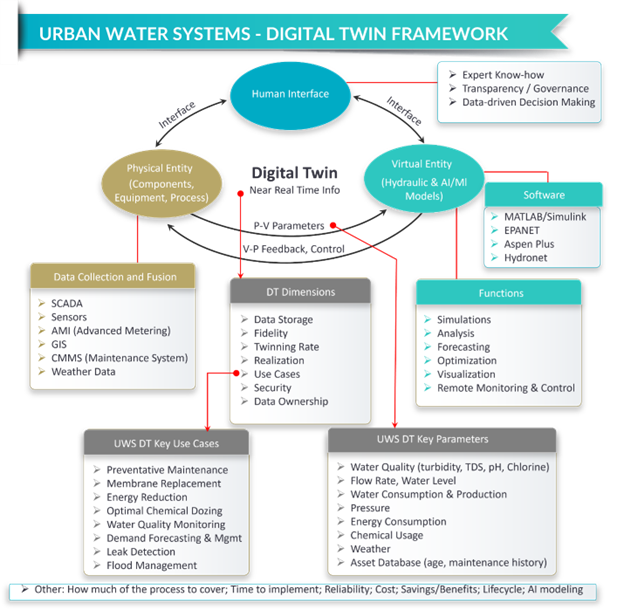Digital twin technology, which involves creating a real-time digital replica of a physical system, has gained significant traction in water management for improving efficiency, reducing costs, and optimizing operations. By leveraging real-time data from sensors and Internet of Things (IoT) devices, digital twins enable utilities and water managers to simulate processes, predict maintenance needs, and optimize operations across desalination, urban water distribution, and water treatment systems. This blog explores real-world examples and results from digital twin implementations, showcasing their transformative impact on water management.
What is a Digital Twin in Water Management?
Digital twins provide a digital replica of water systems, utilizing real-time data and predictive analytics to optimize operations. Digital twins are particularly valuable in water management due to the need for complex, data-driven decision-making. They can adjust to changing variables, such as flow rates, water quality, and system pressure, allowing utilities to detect issues and streamline processes across desalination plants, urban distribution networks, and filtration facilities (Tao & Zhang, 2017).
A. Enhancing Desalination Efficiency Through Digital Twins
Desalination processes are notoriously energy-intensive, with significant operational complexities related to membrane fouling, energy consumption, and brine disposal. Digital twins address these challenges by allowing operators to predict system behavior, optimize energy use, and anticipate maintenance needs.
- Example: NEOM’s Solar-Powered Desalination in Saudi Arabia
Saudi Arabia’s NEOM project, the world’s largest digital city initiative, has integrated a digital twin within its solar-powered desalination plant. By connecting sensors across the plant, NEOM’s digital twin monitors real-time data on energy use, water flow, and membrane performance. This system enables operators to reduce energy consumption by approximately 15% and extend membrane life by predicting fouling rates (Alkhudhayri et al., 2021). Furthermore, NEOM’s digital twin dynamically adjusts energy input based on renewable energy availability, reducing the plant’s carbon footprint and operational costs. - Example: Water Corporation of Western Australia’s Digital Twin for Desalination
The Water Corporation of Western Australia uses a digital twin in its Perth Seawater Desalination Plant, which supplies around 45 billion liters of water per year. The digital twin provides detailed insights into each phase of the desalination process, from intake and pretreatment to RO and brine discharge. After implementation, the plant reported a 12% reduction in energy usage and a 25% increase in operational efficiency due to optimized RO membrane maintenance (Water Corporation, 2020). This digital twin allows for predictive membrane cleaning, minimizing fouling and maximizing water output.
B. Optimizing Urban Water Systems with Digital Twins
Urban water systems often struggle with aging infrastructure, leakage, and fluctuating demand due to population growth. Digital twins allow utilities to visualize the entire network, identify leaks early, adjust pressure, and optimize distribution based on real-time demand, enhancing reliability and reducing waste.
- Example: Singapore’s Smart Water Grid
Singapore’s Public Utilities Board (PUB) has developed a digital twin of its water distribution network, integrating sensors across pipelines to monitor pressure, flow rate, and water quality. The digital twin has enabled PUB to detect and address leaks swiftly, reducing water loss by 25% since implementation. Furthermore, by dynamically adjusting pressure based on real-time demand, Singapore’s smart water grid has improved distribution efficiency by 30% (PUB Singapore, 2019). This system supports Singapore’s water sustainability goals, especially given the city-state’s limited freshwater resources. - Example: Digital Twin in the City of Houston
Houston has implemented a digital twin to manage its vast water distribution system, which serves over two million people. The twin uses data from thousands of sensors to monitor conditions across the network, alerting operators to leaks, contamination risks, or demand surges. This digital twin reduced Houston’s non-revenue water (NRW) losses by 20%, saving the city an estimated $8 million annually (Houston Water, 2020). The system’s predictive capabilities also help the city manage high demand during extreme weather events, such as hurricanes, enhancing resilience and service reliability.
C. Advancing Water Filtration and Distribution with Digital Twins
Water filtration systems must operate efficiently to maintain water quality while minimizing costs and resource use. Digital twins in filtration enable operators to monitor and control filter performance, manage contaminant levels, and optimize maintenance schedules based on predictive analytics.
- Example: Los Angeles Department of Water and Power’s (LADWP) Filtration System
LADWP has implemented a digital twin for its water filtration system, which supplies clean water to over four million residents. By analyzing real-time data on turbidity, pH, and contaminant levels, the digital twin helps operators dynamically adjust filtration processes to maintain water quality. Since implementation, LADWP has reported a 15% reduction in energy costs and a 20% improvement in filtration efficiency (LA DWP, 2020). The twin also provides predictive maintenance insights, reducing downtime and minimizing unexpected system failures. - Example: Thames Water’s Digital Twin for Advanced Water Treatment
Thames Water, the UK’s largest water utility, utilizes a digital twin in its water treatment facilities to optimize filtration and distribution. The digital twin monitors flow rates, water quality, and equipment conditions, providing predictive analytics to improve operational decision-making. After deployment, Thames Water achieved a 10% increase in treatment efficiency and reduced maintenance costs by 12% (Thames Water, 2021). By adjusting treatment processes based on real-time data, Thames Water’s digital twin helps ensure consistent water quality and regulatory compliance.
Benefits of Digital Twins in Water Systems: Real-World Results
Digital twins have demonstrated significant benefits for water systems, as evidenced by the case studies above:
- Operational Efficiency: Digital twins improve operational efficiency across desalination, filtration, and distribution, with reported gains of 10-25% in overall performance.
- Energy and Cost Savings: By optimizing processes, digital twins reduce energy consumption, translating into cost savings. For instance, Water Corporation’s desalination plant in Australia achieved a 12% reduction in energy use, while Houston’s distribution system saved approximately $8 million in water loss prevention.
- Improved Water Quality: Digital twins in filtration and treatment systems allow for real-time adjustments based on contaminant levels, improving water quality and public health outcomes.
- Predictive Maintenance and Reduced Downtime: With predictive analytics, digital twins enable proactive maintenance, reducing downtime by 15-20% across various implementations.
Challenges in Scaling Digital Twin Technology
While digital twins offer substantial benefits, scaling them across water systems faces several challenges:
- High Initial Costs: Implementing digital twins requires investments in IoT infrastructure, data analytics, and software. For smaller utilities, these costs can be prohibitive.
- Data Integration and Quality: Effective digital twins rely on high-quality, consistent data. Many older systems lack compatible technology, posing integration challenges.
- Cybersecurity Concerns: As digital twins become more connected, they expose water systems to cyber threats. Ensuring secure data protocols is essential to protect these critical infrastructures (Murray et al., 2019).
Future Directions and Technological Advancements
Advancements in artificial intelligence (AI) and machine learning (ML) are expected to enhance digital twin capabilities further. AI-driven twins could predict complex scenarios, such as the combined impact of weather events and population surges on water demand, allowing utilities to make even more informed decisions. Additionally, the integration of renewable energy systems, such as solar-powered digital twins, could support sustainability goals, as demonstrated by NEOM’s desalination project.
Conclusion
Digital twins are reshaping the water management industry by offering unprecedented efficiency, predictive capabilities, and real-time insights. Case studies from Singapore, Houston, Los Angeles, and Thames Water showcase how digital twins have led to measurable improvements in energy use, operational costs, and water quality. However, scaling digital twin technology requires overcoming cost, data integration, and security challenges. As more cities and utilities adopt digital twins, the technology’s role in global water sustainability will likely expand, helping address the complex challenges posed by growing populations, climate change, and water scarcity.









